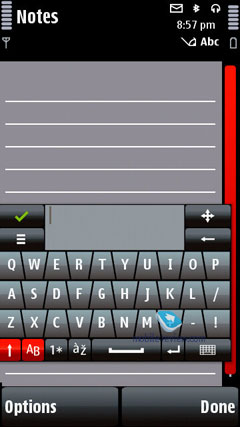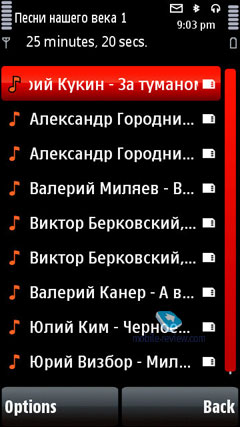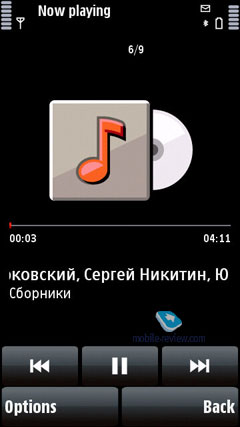|
|
Review of GSM/UMTS-smartphone Nokia 5800 XpressMusic (Tube)
Live photos of the Nokia 5800 XpressMusic
Table of contents:
- Positioning
- Design, Size, Controls
- Display
- Keypad, text input
- Battery
- Performance
- Memory
- USB, Bluetooth, Wi-Fi
- GPS-navigation
- Music department
- Camera
- Impressions
Sales package:
- Handset
- Spare stylus
- Stylus plectrum
- Wired stereo-headset with a remote control (AD-54, HS-45)
- 8Gb microSD memory card
- Carrying case
- Desktop cradle
- TV Out cable
- USB data cable
- Charger
- Software DVD
Positioning
In our reports from the 5800 Tube's launch event we touched upon its positioning, but now we are willing to go more in-depth and give you the big picture.
We've all been waiting for this - a touch-sensitive phone from Nokia. And the more they hyped the fabulous Apple iPhone, the more anxious everyone had been growing. Having launched a PR campaign of immense power Apple did not hesitate to take on Nokia on its very own turf. But Nokia have got some trumps up their sleeves as well, and among them are several solutions that will leave the whole Cupertino sleepless. That is, Nokia Music Store may not seem like much and doesn't look any better than Sony Ericsson's PlayNow service, but Nokia has in fact added a whole new dimension to it by bringing about Nokia Comes with Music campaign that allows the users of select phones to enjoy free subscription to a vast music database. Furthermore, you can store all tracks you've downloaded on PC and listen to them as long as you want. So, this is "strike one" that puts the business model of iTunes in question and makes it less of a monopoly on today's market. But such a powerful service calls for some capable hardware - specifically, music-minded mobile phones. As you probably have guessed, Nokia has tackled this issue with its latest and greatest 5800 Xpress Music.
We already posted an in-depth story about Nokia Comes with Music a while ago, so in case you missed it for some reason, I strongly recommend that you read it.
Moreover, we will put up a review of Nokia Comes with Music the day after it kicks off on October 16th, so we invite you to visit Mobile-Review.com for more info and hands-on impressions with this service.
Although it may seem Nokia have designed the 5800 exclusively for their online music service, it's not quite true. This phone targets all other touchscreen offerings around, including Windows Mobile, Apple iPhone and some dedicated audio players delivered by smaller companies. Basically, Nokia have dropped the price of the 5800 Tube to the point where no one will even want to compete on price or won't have the means to offer a similarly geared solution for this money. But Nokia's real intention behind this sensationally low price tag (by the way, they are still going to make good money off it) is to clean up the whole industry a little bit. Apparently, half-dead manufacturers focusing on touch-sensitive solutions and marketing them at higher price points due to lack of competition won't be able to survive the arrival of the 5800 XpressMusic. However, those who will find a way to adjust without altering their pricing policies will be knocked out early in 2009 by another announcement - without going into much detail, I can say that those 279 Euros for the Nokia 5800 aren't exactly the bottom line for this type of phones; effectively they can go much lower than that.

These days Nokia hardly faces any competition on the mobile phone market - Samsung are capitalizing on the weakness of the rest of the field, and although they've been trying to back it up with pretty decent offerings too, they don't interact with local carriers just as much. So, Nokia's real challenges lie in services and music; obviously, it's impossible not to mention iTues in this regard. Basically, every Apple-branded phone or players comes bundled with iTunes and there is no other way around. Nokia, however, has learned a lesson from Apple's experience and is now looking to take on Apple's offerings on their own turf. How? By now probably everyone knows that the stellar sales generated by the original iPhone in the US were more due to the demand they had to meet in other regions. Apple closed their eyes to all leaks and in an effort to encourage these activities, they supplied "right" people with their firmware encryption codes that essentially made the whole jailbreak hysteria possible (although these days it's nearly impossible to break the iPhone 3G's software). Previously Apple needed to put up great numbers and turn the market in their favor, but that was stage one. The second part of the plan, which is unfolding these days, is supposed to bring the iPhone brand back to the top price bracket. And that's exactly the moment when Nokia chimes in with its underpriced finger-friendly devices, leaving Apple very few ways to retaliate - one of them would be to send the iPhone's pricing through the floor (thankfully, it's not all that popular in Europe). Without a price cut their whole campaign in Europe will come to a halt in a year or two. On the other hand, with unlimited music subscription and a more able device (in terms of core functionality), Nokia won't allow an alternative to come along any time soon.

Now, several words about the phone itself. They call it "feminine", "teenager-ish" and a whole bunch of other ways. But nobody is trying to conceal the fact that it's aimed primarily at the younger audience, although even people past their thirties should be pretty content with the 5800 XpressMusic as well (we'll see some more imposing offerings of this breed down the road, though). Those who are into innovations and cutting-edge gadgets won't be put off by the Nokia 5800's simplistic design. And on the other hand, people who shun touch-sensitive screens won't even think of the 5800 as a possible way to go. This way, Nokia will never face the risk of letting the sales of their conventional smartphones plummet in favor of the 5800 XpressMusic. It's quite another matter, though, that with the arrival of this phone they will have to give up on several music-minded offerings given the price tag of the 5800 Tube.
That said, the Nokia 5800's positioning shouldn't take a rocket scientist to figure out - it's simply the most feature-rich and affordable touchscreen device with a focus on music. Furthermore, you won't find any other phone that can come close to it in terms of price/quality ratio. Windows Mobile devices are by no means "multimedia-ready", so the only other way to go is the Apple iPhone - however, retailing for twice as much, it's not much of a mobile phone per se. And the Nokia 5800 makes it clear that the real price of the Apple iPhone 3G should revolve around 300-350 USD before subsidies. All in all, I suggest we wait until December and see how Apple will alter their pricing policy in view of Nokia's latest efforts on the touchscreen playground.

Again, I never tire to emphasize the following - the 5800 Xpress Music is nothing but Nokia's first step in this segment, and we'll see more of them down the road. What Nokia is really up to is defeat the myth that touch-friendly phones are always on the expensive side - they know it's all nonsense and they are building up a mass market for this type of solutions. And they seem to be doing pretty well, considering how much arguments and feedback their latest release has sparked up.
Back to the table of contents >>>
Design, Size, Controls
The 5800 XpressMusic is a pretty much standard plasticky candy-bar without any metallic or chromed accents in it. The build quality, however, was pretty good - we didn't find any parts on it that would creak when pressed or feel wobbly (just as you'd expect from this design, though). Also, there is nothing wrong with the 5800 Tube utilizing only plastic parts - some more expensive offerings don't have any metallic accents either and somehow this fact doesn't turn many off. Apparently, since the Nokia 5800 doesn't have any other newsworthy drawbacks, its haters will be looking for any opportunity to blame it for not having metallic parts in its design. I especially like some "qualified" opinions of people who haven't even touched the 5800 yet, but for some reason feel competent enough to share their point of view. Here are some gems:
- It's a plasticky made-in-China toy;
- All other touchscreen phones are made of metal, the 5800 is not - why?;
- It looks and feels so cheap!;

Thankfully, though, these mumblings have absolutely nothing to do with how things really stand. As far as materials are concerned, the Nokia 5800 has nothing to shout about, but at the same time it doesn't expose any crucial letdowns.

The phone measures in at 111x51.7x15.5 mm and tips our scales at 109 grams. Let's put it up against some other today's offerings to see how it is "too small" or "way too bulky", "feminine" or whatever:
| Nokia 5800 |
Motorola ZN5 |
Sony Ericsson W902 |
Apple iPhone 3G |
Samsung PIXON M8800 |
| 111x51.7x15.5 mm, 109 g |
118x50.5x16 mm, 114 g |
110x49x11.7 mm, 100g |
115.5x62.1x12.3 mm, 133 g |
107.9x54.6x13.8 mm, 124 g |
Nokia 5800 vs Nokia N85:




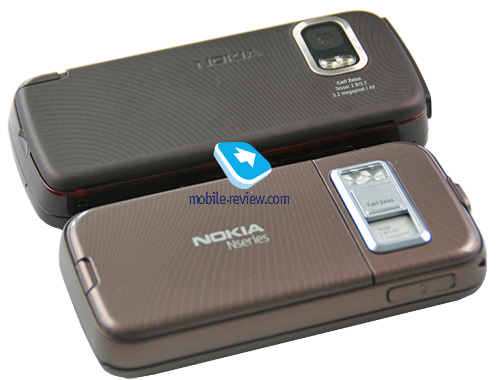
Nokia 5800 vs Nokia N96:



Nokia 5800 vs Nokia 5310:


I suppose the numbers above are more informative than any words - the 5800 is reasonably wide and not overly fat (which some tend to groundlessly blame it for). All in all, in terms of size it's a typical candybar of 2008. It also features a lanyard eyelet that can be used to attach what Nokia calls "stylus plectrum" (comes with a strap on it). I'm pretty positive that some girls will use it as a wrist strap.
Nokia 5800 vs Sony Ericsson W902:




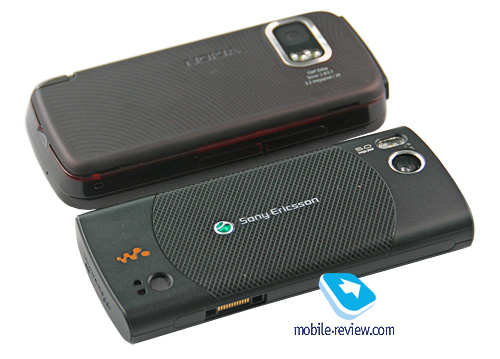
Nokia 5800 vs Apple iPhone:


As far as color schemes are concerned, the Nokia 5800 doesn't offer anything out of this world (three options are available: red, blue and black). Even though Nokia's official product page doesn't show it, the rear cover of the 5800 comes with a distinctive pattern. Running along the sides is a flashy strip color-keyed to the phone's trim.
Housed on the right-hand spine is the volume rocker, display/keypad lock switch and dedicated camera button. More towards the base of the phone there is the stylus silo.



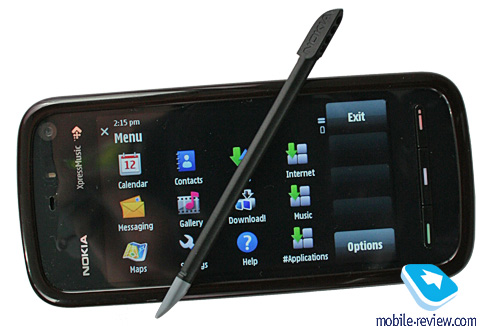
On the left you will find two slots sealed by flaps - one for microSD memory cards, the other one is for SIM cards. The latter is pretty tricky to open, but with the bundled stylus in your hands you won't face and problems with it.

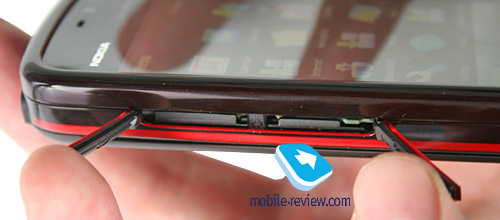
Perched on top is the standard 3.5 mm audio jack along with 2 mm charger socket and mircoUSB connector. Both stereo-speakers are mounted on the left-hand side.

The Nokia 5800 comes boxed with a carrying case made of soft plasticky material - while it's not much at all, it's there and it's free, which is better than nothing. And I believe the 5800 XpressMusic will save you enough money to buy even the most sophisticated carrying case.
The phone comes bundled with a proximity sensor that disables the display when you put it close to your face. One more thing of note - this sensor had been around long before the "One and Only" arrived last July.


Back to the table of contents >>>
Display
One of this phone's fortes is its display, hands down - it's covered by a thick plastic layer, although not recessed into the casing, so it can be handled in any way you please (with bare fingers, stylus or plectrum). At 3.2 inch diagonal, 16:9 aspect ratio, 16 million colors and 640x360-pixel resolution (39x69 mm), the 5800 Tube's screen is a true marvel.

In this department it's closest rival is the Apple iPhone 3G with its 3.5-inch screen and 320x480 resolution; however it can't stand up to the 5800 in terms of picture quality - bigger diagonals can't make up for the lack of resolution (although the iPhone is around 20 percent brighter). On the other hand, on this front both phones do much better than handsets armed with 2-2.6 inch QVGA screens and it's not even close.
Bar the 5800 Tube there will be only one more phone featuring a screen of this caliber - the HTC Touch HD (3.8 inches and 480x800 pixel resolution). However, it doesn't compare quite favourably to the Nokia 5800, since it'll retail for almost thrice as much.
The 5800's screen rotates automatically, depending on what position you hold it in - it takes the phone a split second to change the setup, and generally it is no different from the HTC Diamond or Apple iPhone in this regard.
The phone's display remains fairly legible under direct sunlight, although you might run into certain glitches regarding its readability, but nothing major - the iPhone has got just the same set of problems. The screen can accommodate up to 14 text and 3 service lines; all in all, the 5800's display is perfect for viewing images, videos and browsing long lists.
Screenshots of Nokia 5800's display (below/on the left)
Nokia 5800 vs Nokia N85:





Nokia 5800 vs Apple iPhone:





Nokia 5800 vs Samsung M8800 PIXON:





Back to the table of contents >>>
Keypad, text input
The 5800 houses only three mechanical keys on the front - Call, End and Menu. Pressing the End button anywhere in the phone will get you back to the previous menu level. Also, there are three methods of text input; not methods really, but different keyboards altogether.
The first one is a pretty much standard alphanumeric keypad rendered on the 5800 Tube's display - it kicks in only when you hold the phone vertically and offers a quite convenient way to text with one hand. At the same time, it's next to impossible to do that with the iPhone. I remember how a friend of mine had to stop by the roadside to message me a street address; he was pleasantly surprised with the Nokia 5800's setup however, as it allowed for seamless single-handed operation.
Next up - miniQWERTY keypad, available in both landscape and portrait setups. Clearly, it's much easier to text with it using the plectrum or bundled stylus. The 5800 will enlarge the button you are hovering over. By the way, women won't experience any difficulties with the 5800 - it responds even to slightest touches of fingernails.

The last but certainly not the least - a no-frills QWERTY thumbboard that launches only when holding the phone sideways. It packs in quite sizable buttons that are easy to tap, even with both hands on the screen. All in all, the Nokia 5800 comes with a wealth of texting options - no other phone out three can offer a similar number of options on this front.



When texting with the Prediction feature on you can tap on a word and pick another variant.
Handwriting text input, at least in my opinion, is more of a gimmick, although with the help of stylus you can make it work. I'm not sure whether many actually use it on a regular basis, but it's a saving grace in Asia.
The tactile feedback offered in the 5800 Tube is similar to Samusng's VibeZ technology - the phone vibrates a little whenever you touch it. While it doesn't really feel like you "pressed" a button on the screen, the phone seamlessly reacts to all taps.
Over our quality time with the Nokia 5800 we experienced very few misclicks - all in all, the screen here proved to be pretty responsive and accurate. Also, it allows texting with the full-sized QWERTY-keyboard in all menus (not only in the browser application, like in the iPhone), which is a major plus. In order to deal the text entry issue once and for all we carried out several tests with our focus group: five members used the Apple iPhone on a regular basis, some had no previous experience with touchscreen phones and the rest hadn't used touch-sensitive displays in ages.
We offered all these people to punch in a couple of text fragments, including this one: "The tropical storm churned near the eastern coast of Mexico late Monday and is expected to make landfall in the overnight hours". We used the text input speed achieved with the iPhone's on-screen keyboard as the benchmark for this test - kudos to Apple, it's still one of the finest thumbboards around.
| Parameter |
Apple iPhone |
Nokia 5800 miniQWERTY |
Nokia 5800 miniQWERTY with stylus |
Nokia 5800 full QWERTY |
Nokia 5800 ABC |
| Typing speed |
1 |
1.4 |
1 |
0.8 |
2.1 |
| Number of errors (percentage) |
3% |
4% |
2% |
2% |
1% |
What's the best thing about the Nokia 5800? It comes equipped with a wide array of texting options, and none of them is hard wired, meaning that it's up to you to decide which one suits you best. And there is no way all haters can deny the results of our tests. Although the 5800's on-screen keypads feel somewhat different from that of the iPhone, it won't take you too long to come to grips with the Tube's text input methods.
Back to the table of contents >>>
Battery
The handset utilizes a 1320 mAh Li-Ion battery (BL-5J). The 5800 is rated for 8.8 hours of talk time (GSM) and 400 hours of standby. Music time - up to 35 hours, video recording time (top resolution and quality settings) - up to 210 minutes, video playback time - up to 5 hours.

The handset's battery life averaged 3 days in our tests, when we used the 5800 for about two hours of calls, a dozen or two snaps, several minutes of video, and around an hour of music/radio. It takes the 5800 around one hour to charge from empty to full.
Below is our chart of battery times we managed to squeeze out of the N85:
- GPS-navigation Ц 4-4.5 hours
- Video playback Ц 3 hours 20 minuts (H.264 in speakerphone mode)
- WEB-surfing (EDGE) Ц 4 hours
- Wi-Fi (non-stop data upload) Ц 5 hours
- Music (in earphones) Ц 34 hours
- Radio Ц 25.5 hours
- Games Ц 5 hours
The hardest part of the battery test was to actually see how long it'd take games to drain the 5800's battery. On balance, though, the new Tube is in line with other Nokia's latest and greatest offerings in the way of battery life, furthermore it sets the new record time for a non-stop music session. While you'd expect such a phone to have a less impressive stamina, the 5800 XpressMusic turned out to be a pretty able device on this front.
Back to the table of contents >>>
Performance
Here I'm going to betray my usual rule and ponder over the 5800 Tube's ARM 11 CPU (running at 369 Mhz) in general instead of giving you bare numbers. Nothing amuses me more than claims that every phone's performance hinges solely on its CPU speed. Yeah, right. Wait, no, it doesn't. As far as mobile devices are concerned, it's more about whether their OS is tweaked to go along with certain hardware. That is, Symbian-based solutions rarely need blazing-fast CPUs. The Nokia 5800 is here to prove this once again with its speedy animation and seamless transitions between menus; although there are some minor hiccups here and there, it's still a pretty decent performer overall. I can't remember how many times I've said this already, but the Nokia 5800 XpressMusic is as fast as it gets for this type of smartphones - if you want to make sure of this, just watch our videos where we do a walkthrough around the 5800's interface and menus.
Another question bothering many people around online forums is how well the Nokia 5800 fares in synthetic tests? Way below average. Why? Basically, these tests haven't been turned to evaluate this type of phones at all - they launch in compatibility mode with extra buttons tied up to the screen and show pretty subpar numbers because of that. But again, the 5800's OS is pretty speedy and no one will come out disappointed after trying it once.
Back to the table of contents >>>
Memory
The device comes equipped with 128 Mb of RAM, after first launch you will get around 70-74 Mb of free memory at your disposal, plus there are 81 Mb on top of that reserved in the phone for your personal data. The 5800 deals with microSD memory cards (hot-swappable), the phone comes packaged with a 8Gb unit. There are no restrictions as far as memory card's size is concerned - our handset easily identified a 32Gb card.
USB, Bluetooth, Wi-Fi
USB. Using the USB settings you can choose one of the following modes
- Data Transfer (Mass Storage USB) Ц memory cards is available, no drivers required, as your OS identifies the handset automatically.
- PC Suite Ц used for device management via Nokia PC Suite, enables all features of the phone, data backup etc.
- Image Transfer Ц no explanation required.
- Media Transfer
The 5800's data transfer speeds top out at 5 Mb/s, the phone doesn't recharge itself over USB.
Bluetooth. The phone comes with Bluetooth v2.0, with support for EDR. The following profiles are supported:
- Dial Up Networking Profile (Gateway)
- Object Push Profile (Server and Client)
- File Transfer Profile (Server)
- Hands Free Profile (Audio Gateway)
- Headset Profile (Audio Gateway)
- Basic Imaging Profile (Image Push Responder and Initiator)
- Remote SIM Access Profile (Server)
- Device Identification Profile
- Phone Book Access Profile (Server)
- Stereo Audio Streaming:
- Generic Audio/Video Distribution Profile
- Audio/Video Remote Control Profile (A/V Remote Control Target)
- Advanced Audio Distribution Profile (Audio Source)
The top speed you can get with the 5800's Bluetooth connection is around 100 Kb/s. We also tested its A2DP profile in pair with the Sony Ericsson DS970 headset, which worked just fine - we managed our play list, skipped within tracks and adjusted volume seamlessly, however we couldn't make current track's title show up on the headset's display.
Wi-Fi. This handset comes armed with Wi-Fi (IEEE 802.11 g) support. All security standards are supported, including WEP , WPA , WPA 2, with other advanced settings available. The 5800 boasts the WiFi Wizard, which can search and tap into available networks in background mode.
Back to the table of contents >>>
GPS-navigation
The 5800 Tube comes packaged with Nokia Maps 2.0 application, whose major attraction on this particular device is the ability to control the map itself by touching the screen. Other than that it's little to no different (in fact it does offer slightly more detailed maps) from the version designed for touchscreen-less handsets. But its touch-sensitive display alone makes the 5800 Nokia's finest navigation-savvy offering to date. Plus it utilizes an extremely loud voice for turn-by-turn navigation and allows you to control most of its features right on the screen. All this makes it pretty similar to stand-alone navigators; however over at Nokia they prefer to keep mum about this fact - after all, their navigation-centric smartphones are still around. I won't be surprised, though, if they roll-out a new navigation-heavy phone with a touchscreen some time next September.
Back to the table of contents >>>
Music department
As far as music quality goes, the 5800 offers an unparalleled experience for an S60 device, but while it stands in one line with the N85 and the likes, it can't keep up with the Motorola ZN5, Samsung i8510 INNOV8 and some other solutions. Nevertheless, it's still good enough to take on the Apple iPod, plus less sophisticated users won't notice any difference at all when listening to music in stock earphones.
The 5800 Tube comes boxed with iPhone-grade earphones, meaning that they'll probably be the first thing you will need to get rid of. Custom headphones may be plugged either into the 3.5 mm jack on the phone's casing or the remote control. The latter is nothing to write home about - we have already seen it in several previous phones from Nokia.





As far as our RMAA tests go, the 5800 came pretty close to the Nokia N85 - it wasn't much of a revelation, but seemed like a worthy alternative to many popular stand-alone MP3-players.
| Frequency response (from 40 Hz to 15 kHz), dB: |
+0.11, -0.97 |
Average |
| Noise level, dB (A): |
-85.6 |
Good |
| Dynamic range, dB (A): |
85.2 |
Good |
| THD, %: |
0.0065 |
Very Good |
| IMD, %: |
0.325 |
Average |
| Stereo crosstalk, dB: |
-75.8 |
Very Good |
| Intermodulation at 10 kHz, %: |
0.061 |
Good |
General performance: Good

The following formats are supported: AAC, AAC+, eAAC, eAAC+, MP3, MP4, M4A, WMA, Mobile XMF, SP-MIDI, AMR (NB-AMR), MIDI Tones (poly 64), RealAudio 7,8,10, True tones (WB-AMR), WAV. MP3-files with various bit rates, including VBR, are seamlessly played back by the N81. Upon synchronization with Windows Media Player 11 and higher, you can take advantage of protected DRM-files (Janus DRM).
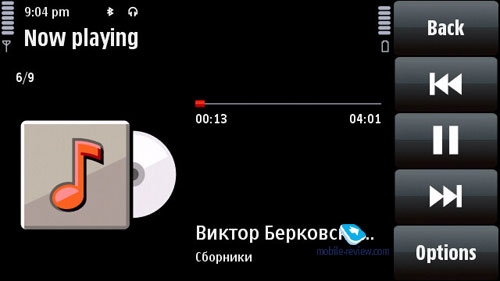
Equalizers. When the equalizer settings are modified the audio experience varies considerably. Every one of the 6 pre-installed equalizers features 8 bands and is fully user-manageable, save for the default settings. The list of presets is as follows - Bass Booster, Classical, Jazz, Pop, Rock. In the Sound Settings you can adjust sound balance, Stereo Widening and Loudness.
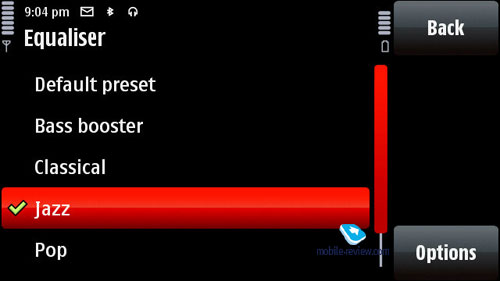

The handset has random and repeat (all or one track) playback modes. When the standby screen is active is displays information about the currently playing track.
Bringing up the Music Menu allows you to browse all tracks, playlists and sort the library by artists, albums, genres and composers. The music library (or the track list) gets updated automatically on every successful synchronization with a PC via Nokia PC Suite except if you use a memory card with pre-loaded tracks. It's worth noting, amongst all the other features, the Library Detail feature..
Podcasting Ц podcasts are now integrated right into the music player, whereas previously they were placed in a separate application. You can access podcasts either from the player's menu or launch the application separately, which will give you access to the library, Nokia's podcast catalogue, search, synchronization settings and so on. You can also choose to get your subscribed podcasts uploaded automatically (within the home network or via some specific access point). All in all this app is a breeze to navigate around and quite useful at that.

Music store Ц allows you to access the Nokia Music Store to buy tracks, albums and download them to your device.

FM-radio Ц the 5800 comes bundled with a pretty standard radio application that offers to pick your region when first launched (this choice will affect the FM frequencies you'll have access to later on). Among its features are RDS, auto tuning and some neat visual enhancements.
Back to the table of contents >>>
Camera
Since Nokia didn't see any point in arming the 5800 Tube with anything more than the bare minimum for the industry on this front, they threw in only a 3.2 Mpix CMOS module with autofocus and macromode (Tessar lens from Carl Zeiss (2.8, 3.7) and dual LED lfash).

The camera application can be activated by punching the side-mounted shortcut key - it takes the 5800 around a second to bring up the viewfinder up to the top. Since the camera interface runs on a touch-sensitive screen, it's pretty easy to browse through all its settings with only a couple of taps. To zoom in/out you will need to use the volume controls. Curiously, due to the camera application's dated design it doesn't support geo tagging

You can go for one of the following resolutions:
- Print 3M Ц Large
- Print 2M Ц Medium
- Multimedia message 0.3M
Scene mode) Automatic, User Defined, Close-Up, Portrait, Landscape, Sports, Night, Night Portrait.
You enabled the screen grid and use the self-timer feature
Effects: Sepia, B&W, Vivid, Negative. White balance - , Sunny, Cloudy, Incandescent, Fluorescent. Contrast - from -2 to +2. Adjustable ISO (low, medium, high) and sharpness


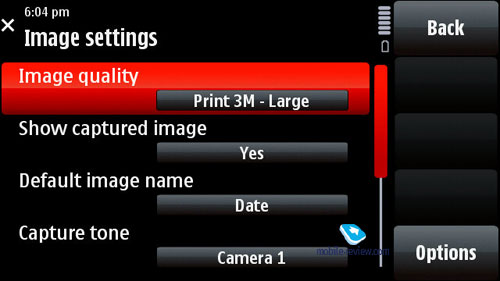






 |
 |
| (+) enlarge, 2048x1536, JPEG |
(+) enlarge, 2048x1536, JPEG |
 |
 |
| (+) enlarge, 2048x1536, JPEG |
(+) enlarge, 2048x1536, JPEG |
 |
 |
| (+) enlarge, 2048x1536, JPEG |
(+) enlarge, 2048x1536, JPEG |
 |
 |
| (+) enlarge, 2048x1536, JPEG |
(+) enlarge, 2048x1536, JPEG |
 |
 |
| (+) enlarge, 2048x1536, JPEG |
(+) enlarge, 2048x1536, JPEG |
 |
 |
| (+) enlarge, 2048x1536, JPEG |
(+) enlarge, 2048x1536, JPEG |
 |
 |
| (+) enlarge, 2048x1536, JPEG |
(+) enlarge, 2048x1536, JPEG |
 |
 |
| (+) enlarge, 2048x1536, JPEG |
(+) enlarge, 2048x1536, JPEG |
 |
 |
| (+) enlarge, 2048x1536, JPEG |
(+) enlarge, 2048x1536, JPEG |
 |
 |
| (+) enlarge, 2048x1536, JPEG |
(+) enlarge, 2048x1536, JPEG |
 |
 |
| (+) enlarge, 2048x1536, JPEG |
(+) enlarge, 2048x1536, JPEG |
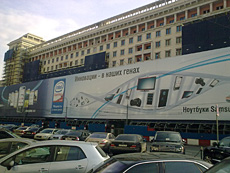 |
 |
| (+) enlarge, 2048x1536, JPEG |
(+) enlarge, 2048x1536, JPEG |
 |
 |
| (+) enlarge, 2048x1536, JPEG |
(+) enlarge, 2048x1536, JPEG |
 |
 |
| (+) enlarge, 2048x1536, JPEG |
(+) enlarge, 2048x1536, JPEG |
 |
 |
| (+) enlarge, 2048x1536, JPEG |
(+) enlarge, 2048x1536, JPEG |
 |
 |
| (+) enlarge, 2048x1536, JPEG |
(+) enlarge, 2048x1536, JPEG |
 |
 |
| (+) enlarge, 2048x1536, JPEG |
(+) enlarge, 2048x1536, JPEG |
 |
 |
| (+) enlarge, 2048x1536, JPEG |
(+) enlarge, 2048x1536, JPEG |
 |
 |
| (+) enlarge, 2048x1536, JPEG |
(+) enlarge, 2048x1536, JPEG |
Video recording. When recording video with 5800, there are considerably fewer settings, than in the still image mode. There is a software image stabilizer that was first introduced in the Nokia N80. You can adjust the white balance, choosing from Automatic, Sun, Cloudy, Incandescent, Fluorescent. The overlay pool includes Sepia, Black&White, Negative. There are only two shooting modes - auto or night mode. Maximum resolution - 640x480 pixels (mpeg4), you can also mute sound, although there is no way you can adjust the 5800's FPS, which is locked at 30. The handset allows recording videos until you run out of free memory
Back to the table of contents >>>
Impressions
Call quality was never an issue with the 5800, as it easily lived up to our expectations of a Nokia-branded phone. Ring tones sounded quite loud and we were happy with them even in noisy environments. The vibro alter was of moderate strength.
You also can mute the 5800's notification sounds and ringtones simply by flipping it face-down.
So, first things first, when the 5800 Tube is going to arrive? On December 5th it will kick off in Russia and several other markets; however the rest of Europe won't see it until early 2009 solely because Nokia don't want to tear up their own portfolio before the Christmas season. The 5800 XpressMusic will retail for 279 Euros before subsidies and rebates on all European markets. Intestingly, while they will face some deficit early on, nobody is going to alter the phone's price tag. It's vitally important for Nokia to stick to the price point they announced several days ago to get themselves another bestselling phone.
Nokia's first touchscreen smartphone isn't a mixed bag by any means. Going for it are a stable OS, decent sales package that very few other phones have, and a wealth of multimedia features onboard. For a moment it may feel like a perfect phone, but there is no such thing, right? In fact it does have some glitches in the way of software (for example when adding the Birthday field the phone automatically closes the contact menu), but we certainly expected to see more of them in this newly designed operating system.
On balance the 5800 Tube offers pretty decent sound quality, audible stereo speakers, WiFi connectivity, and a sizable display that will remain the best on the market for a quite a while. Frankly, I can hardly find anything to criticize the 5800 for, given how little it goes for - there has never been a phone like this before and now it raises the bar to a wholly new level. Well, it's about time I wrapped it all up - no point in praising this phone any further, I suppose.
Another thing of note about the 5800 Tube is that it simply won't face any challenges on the market - the Apple iPhone is a steep, fashion-savvy offering that has been deprived of many standard features, so a comparison between these two phones would seem a little too far-fetched. It does have smoother and more eye-candy menus, similar video capabilities, but that's about it - in fact the iPhone packs in around a tenth of what the Nokia 5800 has to offer in terms of functionality. It wouldn't be right to put them in one league and then berate the iPhone for lacking so many useful feats. So let the iPhone remain the ultimate choice for all fashion-conscious users, while the Nokia 5800 will be the way to go for everyone who is after a well-rounded do-it-all solution.
The revolution is already here and its name is "Nokia 5800 XpressMusic" - there will be no other similarly geared and at the same time well-balanced phone in 2009. It sports an unparalleled price/quality ratio and changes the rules for all phone makers out there, including Nokia itself.
In the next installment of this review we will cover the 5800 Tube's OS - S60 5th edition - as well as all its features and abilities. Don't forget to check back for more!
Related links
Back to the table of contents >>>
Eldar Murtazin (eldar@mobile-review.com)
Translated by Oleg Kononosov (oleg.kononosov@mobile-review.com)
Published — 08 October 2008
Have something to add?! Write us... eldar@mobile-review.com
|
News:
[ 31-07 16:21 ]Sir Jony Ive: Apple Isn't In It For The Money
[ 31-07 13:34 ]Video: Nokia Designer Interviews
[ 31-07 13:10 ]RIM To Layoff 3,000 More Employees
[ 30-07 20:59 ]Video: iPhone 5 Housing Shown Off
[ 30-07 19:12 ]Android Fortunes Decline In U.S.
[ 25-07 16:18 ]Why Apple Is Suing Samsung?
[ 25-07 15:53 ]A Few Choice Quotes About Apple ... By Samsung
[ 23-07 20:25 ]Russian iOS Hacker Calls It A Day
[ 23-07 17:40 ]Video: It's Still Not Out, But Galaxy Note 10.1 Gets An Ad
[ 19-07 19:10 ]Another Loss For Nokia: $1 Billion Down In Q2
[ 19-07 17:22 ]British Judge Orders Apple To Run Ads Saying Samsung Did Not Copy Them
[ 19-07 16:57 ]iPhone 5 To Feature Nano-SIM Cards
[ 18-07 14:20 ]What The iPad Could Have Looked Like ...
[ 18-07 13:25 ]App Store Hack Is Still Going Strong Despite Apple's Best Efforts
[ 13-07 12:34 ]Infographic: The (Hypothetical) Sale Of RIM
[ 13-07 11:10 ]Video: iPhone Hacker Makes In-App Purchases Free
[ 12-07 19:50 ]iPhone 5 Images Leak Again
[ 12-07 17:51 ]Android Takes 50%+ Of U.S. And Europe
[ 11-07 16:02 ]Apple Involved In 60% Of Patent Suits
[ 11-07 13:14 ]Video: Kindle Fire Gets A Jelly Bean
Subscribe
|

































































